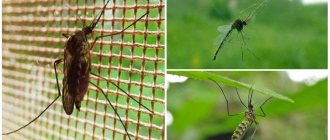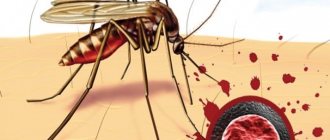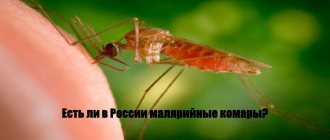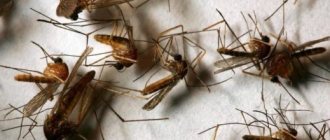Habitat of mosquitoes in Russia
Mosquitoes live throughout Russia. In our country there are about 100 species of these insects. The most common species is the common mosquito, which can be found wherever there are people. Mosquitoes live both in cold Siberia and the Far East, and in the southern regions of the country, for example, in the Krasnodar Territory or Rostov Region.
For most species that carry infectious diseases, Russia is not their usual habitat. But, for example, malaria mosquitoes still occur.
Malaria mosquito
The expert explained when malaria mosquitoes are dangerous
Moscow, June 26. Malarial mosquitoes are widespread in Russia, but there is no reason to panic about their bites, since the very fact that an insect is called malarial does not mean that it necessarily carries this infection. Vadim Maryinsky, a researcher at the Department of General Ecology and Hydrobiology, Faculty of Biology, Moscow State University, spoke about this.
“If we talk about the entire planet, the most dangerous, sometimes fatal infection spread by mosquitoes is malaria. It is caused by a single-celled parasite carried by Anopheles mosquitoes. That's what they're called: malaria mosquitoes. They are also widespread in Russia. During the season, any person outside the city is repeatedly bitten by malaria mosquitoes,” the scientist noted on Sputnik radio.
Some media reported that the death of gambusia fish, also called “mosquito fish,” due to winter frosts in the south of the Russian Federation, could lead to an increase in the number of mosquitoes, including malaria ones, since these underwater inhabitants eat the larvae of bloodsuckers.
However, Maryinsky is confident that there is no need to panic about this, since the fact that a mosquito is called malaria does not necessarily mean that it is a carrier of this infection.
According to him, malaria mosquitoes can be dangerous, that is, they can infect humans with infections if they themselves are its carriers. But if they don’t have it, then the bite is not terrible.
“In the south of Russia there were once hotbeds of malaria, but work carried out in the 19th century to drain the swamps made it possible to solve this problem. Today in Russia there are pinpoint, very small outbreaks of malaria. It can be brought from tropical regions,” the specialist explained.
The expert clarified that an untrained person is unlikely to be able to distinguish an ordinary mosquito from a malaria one, and therefore urged people not to try to view the remains of every killed insect with suspicion.
Maryinsky also added that ordinary mosquitoes can also transmit some infections. For example, in the southern Russian regions they can be carriers of the larvae of one type of helminth - dirofilaria. Unlike malaria, which has no natural foci in the Russian Federation, such cases do occur, but are extremely rare.
Earlier, a simple folk recipe using vanillin appeared on the Utro.ru portal to repel midges and mosquitoes. The publication notes that, unlike many store-bought products, this actually works and does not have a strong odor.
How dangerous are mosquitoes?
Bites from mosquitoes and their close relatives, mosquitoes, pose a danger to human health. Main negative factors:
- an allergic reaction caused by insect saliva entering the human body;
- skin diseases arising from initial skin lesions;
- the likelihood of infection of wounds from bites and, as a consequence, the development of an inflammatory process, an abscess;
- high risk of infection with infectious diseases whose pathogens are carried by insects.
In addition, mosquitoes cause severe psychological discomfort, especially in the warm season. Their annoying flickering before the eyes, disgusting squeaking, constant attempts to sit on open areas of skin irritate, interfere with sound sleep, and turn outdoor recreation into a struggle for survival.
Mosquito-borne diseases
Mosquitoes are carriers of viruses, bacteria, and pathogenic microorganisms that, when entering the human body, provoke the development of various diseases. Each disease has its own clinical picture, incubation period, treatment regimen and prognosis.
Malaria
Infection with malaria or swamp fever is what is dangerous in the bites of female mosquitoes belonging to the genus Anopheles. The body of infected insects contains protozoan parasites of the genus Plasmodium. At the moment of a bite, they enter the human blood through the wound with the insect’s saliva and are carried throughout the body by the bloodstream.
Main symptoms of the disease:
- fever (attacks most often occur at regular intervals);
- headache;
- excessive sweating;
- chills;
- nausea;
- severe weakness;
- general malaise;
- muscle and joint pain;
- sleep disorders;
- convulsions;
- enlarged spleen;
- liver dysfunction.
The danger of the disease lies in its long incubation period. The first signs of malaria can appear either 10–15 days after the bite or 1–2 years later. The most severe form of the disease is tropical malaria, which is often fatal.
Zika disease
Zika fever is another disease that can be contracted from mosquitoes. The causative agent of the disease is a virus from the genus Flavivirus. It is transmitted by mosquitoes of the genus Aedes (particularly the yellow fever mosquito and the Asian tiger mosquito). The most dangerous regions where it is easiest to become infected with the Zika virus are South America, Africa and Oceania.
Consequences of the disease
The main signs of the disease include:
- fever;
- heat;
- large rash affecting large areas of skin;
- redness of the eyes.
The disease poses a particular danger to pregnant women, since in many cases the child is born with a birth defect - microcephaly, and less often with other developmental pathologies. In recent years, scientists have been sounding the alarm due to the growing number of infections and the high probability of the disease spreading throughout the world.
Lymphatic filariasis
When listing what diseases mosquitoes carry, one cannot fail to mention lymphatic filariasis. This disease, also known as elephantiasis, is one of the neglected tropical diseases. The causative agents are roundworms from the genus Filarioidea. The main vectors are mosquitoes of the genus Culex, Anopheles and Aedes. A mosquito, having bitten a sick person, becomes infected with microfilariae, that is, immature larvae. Once in the insect's body, the parasites develop, becoming full-fledged larvae.
After an infected mosquito bites a person, the larvae enter the body, migrate to the lymphatic system, where they develop into adult nematodes. During the life of parasites, the immune and lymphatic systems are affected, elephantiasis (tissue thickening), lymphatic edema, and skin inflammation develop. The disease often leads to disability and even death of the patient.
Tularemia
The main carriers of tularemia are small rodents, hares and rabbits. The carriers are blood-sucking insects - mosquitoes, mosquitoes, ticks, horseflies. This infectious disease, transmitted by ordinary and stinging mosquitoes, is characterized by the following symptoms:
- a sharp increase in temperature up to 40⁰С;
- fever;
- weakness, dizziness;
- low pressure;
- severe intoxication;
- headache;
- pain in joints and muscles;
- enlarged lymph nodes;
- grayish coating on the tongue;
- pinpoint hemorrhages in the oral cavity;
- redness and swelling of the face.
Tularemia
There are several forms of the disease, depending on which systems of the human body are affected.
Yellow fever
Yellow fever is another disease caused by an infection that enters the human body during a mosquito bite. The disease got its name because of one of the symptoms - the patient’s skin acquires a characteristic yellowish tint. This is associated with developing liver failure.
There are two forms of the disease: jungle fever and community fever. The first is transmitted to humans by blood-sucking insects from sick monkeys, the second passes from an infected person to a healthy person after the bite of a mosquito of the genus Aedes aegypti. The second form is more dangerous, as it causes the majority of outbreaks and epidemics.
Symptoms of yellow fever:
- heat;
- nausea, vomiting;
- Strong headache;
- muscle pain.
Due to vascular damage, internal bleeding occurs in the gastrointestinal tract. The functioning of the kidneys and liver is impaired.
West Nile fever
West Nile fever is a seasonal infectious disease caused by mosquito bites. The virus, entering the human body through the bloodstream, penetrates the central nervous system and brain. As a result, pathological processes develop that cause symptoms such as:
- a sharp increase in temperature to 39 - 40⁰С, accompanied by severe chills;
- intense headache;
- muscle pain (especially neck and lower back);
- swollen lymph nodes;
- redness of the skin, appearance of a rash;
- lack of appetite;
- vomit;
- pain in the heart area;
- whitish coating on the tongue;
- redness of the eyes.
Half of the patients are diagnosed with serous meningitis.
The mortality rate for West Nile fever is about 5%.
Dengue fever
Dengue fever is caused by viruses from the Flaviviridae family, genus Flavivirus. The vectors are Aedes aegypti and Aedes albopictus mosquitoes. Main symptoms of the disease:
- sudden loss of strength;
- dizziness;
- nausea;
- fever;
- itchy rash (appears first on the torso, then spreads to the limbs);
- swollen lymph nodes;
- severe pain in joints and muscles;
- redness of the face, eyes, throat;
- swelling of the face.
Joint pain
Not only the disease itself is dangerous for a person, but also the complications it can cause:
- encephalitis;
- infectious-toxic shock;
- pneumonia;
- meningitis;
- polyneuritis.
In case of timely and competent treatment, the prognosis is favorable in most cases.
Can you get AIDS from a mosquito?
Considering that mosquitoes feed on blood and bite all people indiscriminately, a reasonable question arises: is it possible to become infected with HIV after a mosquito bite? Indeed, theoretically the insect can carry HIV. However, cells of the immunodeficiency virus quickly die upon contact with the external environment, so a mosquito that has drunk the blood of a person with AIDS poses a threat for a very short time.
Potential danger to the next victim exists only if the mosquito bites her immediately after drinking the blood of an infected person. But in reality, such a situation is unlikely to happen, because a satiated insect needs time to digest the food. And by the time the mosquito flies out to hunt again, the virus will no longer be viable, and therefore not dangerous.
Mosquitoes and diseases: mechanism of transmission from mosquito to human.
HIV, hepatitis and other diseases cannot develop in the body of the mosquito itself. There are two main reasons for this:
1) Most human viruses die quite easily. They need a breeding environment. For example, hepatitis multiplies well in the liver, but in the blood it survives for a very limited time. 2) The mosquito does not inject anything into the victim’s body except saliva. But mosquito saliva itself is dangerous as a distributor of many viruses, although many of them, such as HIV and hepatitis, do not survive in it.











